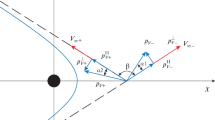Abstract
In the paper, the problem of designing interplanetary trajectories with several swing-bys and deep-space maneuvers is solved using the method of virtual trajectories developed by the authors. The algorithms for the calculation of both heliocentric and planetocentric trajectory arcs are presented, including the case of resonant trajectories. The results of applying the method of virtual trajectories to the problem of designing an interplanetary transfer to Jupiter are given and compared with the baseline trajectories for the Juno, Europa Clipper, and Laplace missions.
Similar content being viewed by others
References
Di Lizia, P., Radice, G., Izzo, D., and Vasile, M., On the solution of interplanetary trajectory design problems by global optimisation methods, in Proc. Global Optimisation Workshop, Almería, Spain, 2005, pp. 159–164.
Okhotsimskii D.E. and Sikharulidze, Yu.G., Osnovy mekhaniki kosmicheskogo poleta (Basics of Space Flight Mechanics), Moscow: Nauka, 1990.
Levantovskii, V.I., Mekhanika kosmicheskogo poleta v elementarnom izlozhenii (Elementary Space Flight Mechanics), Moscow: Nauka, 1980.
Hughes, G. and McInnes, C.R., Solar sail hybrid trajectory optimisation, Adv. Astronaut. Sci., 2001, vol. 109, pp. 2369–2380.
Rogata, P., Di Sotto, E., Graziano, M., and Graziani, F., Guess value for interplanetary transfer design through genetic algorithms, in Proc. 13th AAS/AIAA Space Flight Mechanics Meeting, Ponce, Puerto Rico, 2003, AAS03-140.
Dachwald, B., Optimization of solar sail interplanetary trajectories using evolutionary neurocontrol, J. Guid. Control Dyn., 2004, vol. 27, no. 1, pp. 66–72.
Wirthman, D.J., Park, S.Y., and Vadali, S.R., Trajectory optimization using parallel shooting method on parallel computer, J. Guid. Control Dyn., 1995, vol. 18, no. 2, pp. 377–379.
Hartmann, J.W., Coverstone-Carroll, V.L., and Williams, S.N., Optimal interplanetary spacecraft trajectories via a Pareto genetic algorithm, J. Astronaut. Sci., 1998, vol. 46, no. 3, pp. 267–282.
Vasile, M., A global approach to optimal space trajectory design, Adv. Astronaut. Sci., 2003, vol. 114, pp. 621–640.
Sentinella, M.R., Comparison and integrated use of differential evolution and genetic algorithms for space trajectory optimisation, in Proc. IEEE Congress on Evolutionary Computation, Singapore, 2007.
Storn, R.M. and Price, K.V., Differential evolution—A simple and efficient heuristic for global optimization over continuous spaces, J. Global Optim., 1997, vol. 11, pp. 341–359.
Storn, R.M., Price, K.V., and Lampinen, J.A., Differential Evolution: A Practical Approach to Global Optimization, Springer, Berlin, 2005.
Kennedy, J. and Eberhart, R., Particle swarm optimization, in Proc. IEEE International Conference on Neural Networks, Perth, Australia, 1995.
Fedotov, G.G., Optimization of flight trajectories of a spacecraft with electric propulsion using the gravitational maneuver, Cosmic Res., 2004, vol. 42, no. 4, pp. 389–397.
Grigoriev, I.S. and Grigoriev, K.G., The use of solutions to problems of spacecraft trajectory optimization in impulse formulation when solving the problems of optimal control of trajectories of a spacecraft with limited thrust engine: I, Cosmic Res., 2007, vol. 45, no. 4, pp. 339–347.
Petukhov, V.G., Optimization of interplanetary trajectories for spacecraft with ideally regulated engines using the continuation method, Cosmic Res., 2008, vol. 46, no. 3, pp. 219–232.
Lancaster, E.R. and Blanchard, R.C., A unified form of Lambert’s theorem, NASA technical note TND-5368, 1969.
Gooding, R.H., A procedure for the solution of Lambert’s orbital boundary-value problem, Celestial Mech. Dyn. Astron., 1990, vol. 48, no. 2, pp. 145–165.
Kowalkowski, T.D., Johannesen, J.R., and Lam, T., Launch period development for the Juno Mission to Jupiter, Proc. AIAA/AAS Astrodynamics Specialist Conference and Exhibit, Honolulu, Hawaii, 2008, AIAA2008–7369.
Buffington, B., Trajectory design for the Europa Clipper mission concept, Proc. AIAA/AAS Astrodynamics Specialist Conference, San Diego, California, 2014, AIAA2014–4105.
Boutonnet, A. and Schoenmaekers, J., JUICE: Consolidated report on mission analysis (CReMA), ESA WP-578, no. 1, Darmstadt, Germany: ESA: 2012.
Author information
Authors and Affiliations
Corresponding author
Additional information
Original Russian Text © M.G. Shirobokov, S.P. Trofimov, M.Yu. Ovchinnikov, 2018, published in Kosmicheskie Issledovaniya, 2018, Vol. 56, No. 4.
Rights and permissions
About this article
Cite this article
Shirobokov, M.G., Trofimov, S.P. & Ovchinnikov, M.Y. Design of Interplanetary Transfers with Passive Gravity Assists and Deep Space Maneuvers. Cosmic Res 56, 317–330 (2018). https://doi.org/10.1134/S0010952518040044
Received:
Published:
Issue Date:
DOI: https://doi.org/10.1134/S0010952518040044



